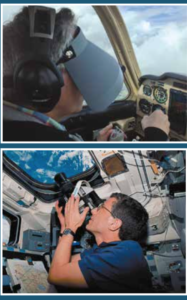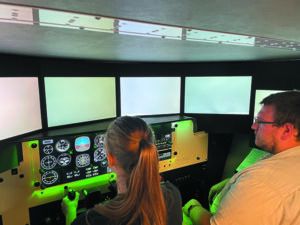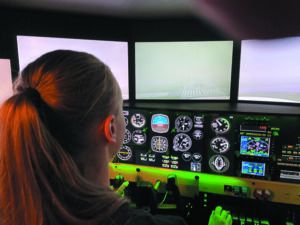We started to learn about the rapid deterioration of instrument skills and knowledge as we worked on the rating. If we laid off from training for more than a week, we found that we had to do more than a little review during the next lesson to unfog our brains on procedures and focus extra carefully to hold altitude, heading and speed within the parameters set by that unreasonably demanding, evil CFII in the right seat.
Once we had the rating it was unpleasant to discover just how fast the rust could set in. There were times that we launched with a safety pilot, put on the foggles and immediately put the airplane through a some gyrations while suffering a bit of spatial disorientation before we could settle down and keep the airplane going where we wanted.
Then there were the accident reports we looked at—pilots who were IFR legal, but lost control shortly after punching into the clouds or couldn’t seem to fly an approach in IMC.
It was about then that the reasoning behind the FAA regs on instrument currency began to sink in—but we also got the nagging feeling that being instrument legal wasn’t necessarily being instrument safe.
THE REGS
FAR 61.57(c) requires that a person desiring to be PIC under IFR or less than VFR weather conditions must have performed six instrument approaches, holding procedures and tasks and intercepting and tracking courses through the use of navigational electronic systems.
FAR 61.57(d) explains what happens if a pilot hasn’t met those requirements for more than six months: She has to successfully complete an instrument proficiency check (IPC)—and it sets out what is involved in the IPC.
We’ll interject right here something that a lot of instrument-rated pilots have forgotten—you have to be instrument current to operate under an instrument clearance. If it’s a lovely day and you want to file IFR and get a clearance to get some practice in the system, you have to be IFR current and legal—even if there’s not a cloud in the sky. And, yes, we know some pilots who have had some unpleasant interactions with the FAA on that subject.
Word to the wise: If you aren’t IFR current, don’t file IFR; use flight following if you want to talk with a controller.
IMPOSSIBLE TO FAIL
Our informal research indicated that the majority of instrument pilots who take an IPC do so because they let their IFR currency lapse. At the same time, many of those we talked to about taking an IPC had what we thought was a surprising level of anxiety over the whole thing.
When it comes to considering an IPC, we like Douglas Adams’ straightforward advice from his book The Hitchhiker’s Guide to the Galaxy: Don’t Panic. That’s because it’s impossible to fail an IPC. The worst that can happen is that you don’t complete it. It’s a pure “train to proficiency” exercise. You’re getting the rust off.
Once you meet the standards you receive a logbook endorsement that you have successfully completed an IPC and you may go forth and file and fly IFR for the next six months. Life is good.

Dr. Jay Apt is currently the co-director of Carnegie Mellon University’s Electricity Education Center. Prior to that he spent some time with an outfit that goes by the acronym NASA where he was an astronaut on four Space Shuttle missions—STS-37, STS-47, STS-59 and STS-79—during which he spent 847 hours in space and made two spacewalks. He is a commercial, instrument, mult-engine and seaplane pilot with over 6500 hours of flying time.
Since we’ve known Dr. Apt, he’s taken an IPC every six months, give or take a month. We asked him about his approach to recurrent training. He sent us the following email:
“Living on the windward side of the Allegheny mountains, I have no problem getting six IMC approaches every six months. Since I fly up to New York and New England a lot even the holding requirement is pretty often satisfied. I try to stay sharp by doing three approaches at my home drome pretty much any week that I’m not flying somewhere else. I do those in whatever weather happens to be visiting that day, so can’t log most of them. But even in VMC that keeps my scan and procedures up to snuff. When the plane is down for an annual or I miss a week for another maintenance issue, I fire up X-Plane configured with my V35B Bonanza panel and my Saitek yoke. Not logable, but helps proficiency.
“So, why do I fly with a good CFII every six months or so to do an IPC and FR? One reason is to work harder than I do on most IFR or even IMC flights: We fly to several airports in quick succession in places I don’t regularly go. That helps me organize my cockpit and mental tasks. Another is to practice things I don’t do on my own (steep turns under the hood, unusual attitudes, simulated engine outs). I’m also there to have the instructor see if I’ve developed any bad or lazy habits. Finally, it is good to see if my personal standards need sharpening (tolerance for altitude deviations or landing off the centerline, for example). I come out of the session more confident and feeling good that I’ve flown with someone who has made me better when the weather gets nasty.”
The photos are of Dr. Apt under the hood during an IPC, top, and operating in VMC conditions, bottom.
—Rick Durden
GETTING STARTED
We’ll start from the assumption that you are like most other instrument pilots facing an IPC—you aren’t instrument current and you have developed some degree of rust on your IFR knowledge and skills. That’s fine. You got your instrument rating once upon a time, so you have a good idea what you need to review and at what level you’ll need to fly to complete an IPC. If it’s been a few years, the chances are that there have been a few changes in the regs and instrument operating procedures, so using your 2005 FAR/AIM and ground school materials might not be the best place to start.
There are a number of commercially available IPC review materials, but because we’re tightwads and the free stuff out there is so good, we’re going to stick with the free stuff in this article.
Your hard-earned tax money helped pay for FAA publications on instrument flying, so it can feel good to simply go to www.faa.gov and read the IFR material on it. Believe us, there’s so much that your lips are going to get tired.
We suggest starting with the Instrument Proficiency Check Guidance booklet. It’s a good combination of overview of the subject and in-depth exploration of the various subjects to get you we’ll on your way to your IPC.
Next, pull up Advisory Circular AC 61-98D. It includes material on flight reviews in addition to the IPC.
Since you are going to go flying with a CFI, we recommend turning the session into a joint IPC and FR. Sure, you might not need a FR, but taking one before you are due is like chicken soup—it cain’t hurt, and it may do good things for your skill level and further reduce the risk that you’ll roll an airplane up into a ball.
Other free reference material on the FAA’s website is FAR Part 91 that you’ll want to review for the most current IFR operating rules; the Aeronautical Information Manual—in its most current form; the Instrument Flying Handbook; Instrument Procedures Handbook; Aviation Weather and Weather Services; and the instrument rating Airman Certification Standards (ACS).
STRATEGY
Once you’ve gotten reasonably buried in review materials, we suggest that you come up for air and have a conversation with the instrument instructor that you’re going to be flying with for the IPC. In our opinion, we think that the conversation should be a give-and-take exercise in which you talk about the type of instrument flying that you do—or wish to do—as we’ll as what you think you need to work on in your instrument flying. The instructor should discuss what she wants to see during an IPC and the general completion standards. We also recommend discussing the stuff that instrument pilots don’t do regularly—so it might be wise to practice during the IPC—such as various emergencies, avoiding loss of control events and generally maneuvering the airplane beyond the realm of standard rate turns in cruise flight—steep turns, slow flight and stalls.
We strongly recommend scenario-based training as part of an IPC. We think good instructors have some favorite scenarios in their bag of tricks. We suggest talking about scenarios ahead of the IPC with your instructor—both the ones the instructor likes and any that you might suggest.
We do not think that an IPC should be a “stump the chump” exercise. The purpose is to get the rust off of you and bring you up to where you are not only competent to operate safely IFR but also confident to do so. That means a team effort with an instructor who sets you up to succeed by elevating your skills and challenging you in the process.
After talking with your instructor we think you should be going into your IPC that has been tailored for you, fully knowing what to expect.
WHAT’S REQUIRED

As part of the strategy/scenario discussion, there is the need to make certain that the IPC covers at least all of the material required under 61.57(d): ATC clearances and procedures; flight by reference to instruments; navigation systems; instrument approach procedures; emergency operations and postflight procedures.
61.57(d)’s language is pretty broad so the FAA went into detail in Appendix 5 (at page A-12) to the ACS for the instrument rating. That takes the 61.57(d) general requirements and sets out specific portions of the ACS that are applicable to an IPC. By identifying only some parts of the ACS as required in an IPC, the FAA has made it clear that an IPC is not a full instrument checkride. If you run into an instructor who tells you that you’ll have to do everything on an instrument rating checkride for an IPC, the ACS itself shows that isn’t so.

DISAGREEMENT
This is an appropriate time to explore one of the unpleasant situations instructors sometimes face when giving an IPC—the pilot thinks he’s done great and is entitled to a signoff while the instructor is convinced that the pilot isn’t yet up to snuff.
In our experience, this situation can arise because the instructor is either setting the bar too high or is behaving unethically in requiring more instruction in order to make more money off of the pilot. The ACS standards can help the pilot show that she’s performing at a satisfactory level—although the usual fix is to fly with another instructor. One who is reasonable. Fortunately, we think this situation is rare.
The more common problem is that of a pilot who does not self-evaluate we’ll and does poorly during the session, but is convinced he’s the greatest gift to instrument flight and demands to receive an endorsement. That is where objective standards for tolerances for airspeed, altitude and heading control protect the instructor. When the ACS calls for holding altitude plus or minus 100 feet and the pilot was 200 feet off of the assigned altitude four times, no matter how much the pilot argues that he did fine, the instructor has solid evidence supporting his unwillingness to sign off the pilot.
We strongly recommend that during the pre-IPC conversations that the pilot and instructor agree on the standards for completion with as many objectively identifiable markers (such as altitude tolerance) as possible—and they cannot be less strict than the ACS numbers.
We recommend agreement on performance standards for an additional reason—how hard you have to work to meet them, and how close you come to busting them, provide good guidance to you personally in deciding what kind of weather you should be flying in.
AIRPLANE OR SIMULATOR?
The airplane versus simulator for training debate was settled years ago—game, set, match to the simulator. You can accomplish much more training in the available time, it’s less expensive and it doesn’t leave smoking holes in the ground when someone makes a mistake.
The FARs allow the use of at least an AATD (Advanced Aviation Training Device) or higher flight simulator for an IPC. No desktop units.
The ACS requires that an IPC include a circle-to-land approach—and engine-out work if flying a multi-engine airplane. Whether the particular simulator can be used for those portions of the IPC should be shown in the paperwork for the individual simulator. You may be able to perform an entire IPC in the sim or you may have to do some portion in an airplane.
If you’re a pilot coming for an IPC because you’ve let your currency lapse, our recommendation is to do as much of the IPC in a simulator as you can simply because it’s more cost-effective. However, we also recommend that you do at least part of it in an airplane because there are some things that a simulator cannot re-create, such as turbulence-induced spatial disorientation or simply physical discomfort that affects your ability to fly the airplane.
We also suggest that unless the simulator panel pretty closely matches the instrument presentation and avionics in the airplane you regularly fly, that you do at least part of the IPC in the airplane you regularly fly.
SOME DETAILS

No matter why you are taking an IPC, we suggest that during the ground session prior to the flight that you cover some material beyond the standard FAR and instrument procedures review. We recommend a little time with the POH to discuss aircraft systems, what can go wrong and the appropriate response to those problems. We also like to look at the most recent Used Aircraft Guide in this magazine for the type of aircraft being flown to see if there are any accident trends that might be significant. We also like to look at the accident reports in the recent issues of our sister publication, Aviation Safety, to see what problems pilots are having in the IFR world.
DEBRIEF
Once you’ve put the airplane or simulator away we think that a detailed debriefing is of great value. We’ve seen instructors who have the pilot write up an evaluation of the flight and include her day and night, precision, non-precision and circling personal weather minimums—while the instructor is doing the same thing. We like it. In our experience the instructor’s and pilot’s write-ups match closely. The times that they don’t—usually the pilot overrates herself—is a red flag that more work and serious discussion is needed.
The reality is that by the end of an IPC the pilot is very glad he’s gone through the process and is much more confident about flying IFR, while being aware that he’s certainly not going to try shooting an ILS to 200-and-a-half in blowing snow. Combined with constructive feedback from the instructor, the pilot is almost invariably back to a solid level of instrument flying competency.
FREQUENCY
Being evaluated is no fun. That’s the real reason, in our opinion, most pilot put off taking a flight review until the last possible minute and do their best to stay instrument current by doing the six approaches stuff every six months.
We have a suggestion based on years of looking at accident reports. It’s a hard data point—pilots who take regular recurrent training have a much lower accident rate than those who don’t. The insurance companies know this and are increasingly requiring more frequent recurrent training for aircraft owners—that has made Part 91 corporate aviation’s safety record every bit as good as, or better than, Part 135 operations.
So—why not take an IPC (and FR) every six months or so? After all, you know how good you feel when you finish an IPC. You also know how much safer you’ll be.
Schedule the first one now.


